Squat analysis
In off season and during the season multiple different sports athletes will have to do squats as a part of their training routine to develop stronger foundation for their specific sports. Many athletes will use squats. Team sports such as, football, American football as well as individual sports such as tennis, running, cycling. The compound exercise/movement, such as squat, is going to activate multiple muscle groups and joints at the same time.
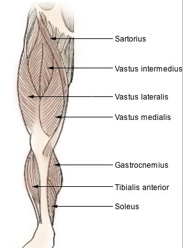 During squat the muscles that are going to be targeted mainly are the quadriceps (group of muscles) and gluteus maximus. When squatting, quadriceps and gluteus musles are going to be the agonists. Quadriceps also called as quadriceps femoris has four heads which is the translation from Latin “four-headed muscle of the femur” (femur – the long bone the quadriceps muscles surround). Four heads of the quadriceps are the lateral head/vastus lateralis (outside of the leg), medial head/vastus medialis (inside of the leg (important for knee health), and vastus intermedialis (between the two other heads) this head is under the rectus femoris which is the fourth head of the quadriceps.
During squat the muscles that are going to be targeted mainly are the quadriceps (group of muscles) and gluteus maximus. When squatting, quadriceps and gluteus musles are going to be the agonists. Quadriceps also called as quadriceps femoris has four heads which is the translation from Latin “four-headed muscle of the femur” (femur – the long bone the quadriceps muscles surround). Four heads of the quadriceps are the lateral head/vastus lateralis (outside of the leg), medial head/vastus medialis (inside of the leg (important for knee health), and vastus intermedialis (between the two other heads) this head is under the rectus femoris which is the fourth head of the quadriceps.
Gluteus Maximus (largest muscle in the human body) is the second muscle that is targeted during squat which is also an agonist. Both quadriceps and gluteus Maximus are working together to achieve the extension of the leg and therefore knee extension. The gluteus Maximus is heavily activated during the concentric phase of the squat therefore it is important to have great range of movement to for greater muscle fibre recruitment in gluteal muscles. This will happen because there will be longer distance to travel to achieve full extension of the knee and hip. Gluteus maximus originates from coccyx, sacrum and iliac crest which provides large base for attachment.
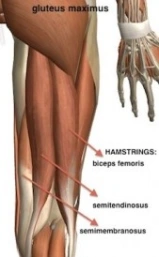
Hamstrings are also the heavily involved in the squats, they act as synergists which means that they help to create the movement as well as stabilise it. Hamstrings has three heads which are biceps femoris, semitendinosus and semimembranosus. Hamstrings shorten during concentric phase to bring the knee in extension. Hamstrings lengthen during the eccentric phase (negative movement) to flex the knee. In the study “Hamstring activation during lower body resistance training exercises, by Edden, International Journal of Sports Physiology and Performance, 2009” using EMG (Electromyography) it was found that hamstrings are not recruited significantly when comparing to other hamstring exercises such as seated leg curls, good mornings and Russian curls where EMG activity was much greater. Therefore, this study suggests that squat is the least effective for recruiting muscle fibres in hamstrings compared to other hamstring movements.
Secondary muscles that are worked when squatting are calves. Gastrocnemius (has two 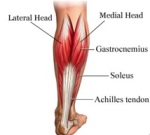 heads, medial and lateral) and soleus. Gastrocnemius originates from lower femur but soleus from tibia. Both insert in heel bone (calcaneus). Both muscles are responsible for plantar flexion of the ankle during the squat which is going to occur during the concentric phase of the squat when the angle between the sole of the foot and femur will increase.
heads, medial and lateral) and soleus. Gastrocnemius originates from lower femur but soleus from tibia. Both insert in heel bone (calcaneus). Both muscles are responsible for plantar flexion of the ankle during the squat which is going to occur during the concentric phase of the squat when the angle between the sole of the foot and femur will increase.
 The antagonists during the squat are hip flexors. Hip flexors allow the flexion of the hip (see image). There are multiple hip flexors, these include inner hip muscles (iliopsoas) which are the main flexors of the hip, but there are many others that are important in flexion. These include front muscles of the thigh (rectus femoris, Sartorius) as well as Gluteus Maximus works as hip flexor.
The antagonists during the squat are hip flexors. Hip flexors allow the flexion of the hip (see image). There are multiple hip flexors, these include inner hip muscles (iliopsoas) which are the main flexors of the hip, but there are many others that are important in flexion. These include front muscles of the thigh (rectus femoris, Sartorius) as well as Gluteus Maximus works as hip flexor.
During squat whole body has to be tight, shoulder blades (retracted) need to be pulled together, posterior chain, and back muscles need to be pulled together (retracted).During squats core muscles are also going to be involved as they ensure that body can be held upright avoiding forward lean.
Squats start by tightening your gluteus maximus, chest up, shoulders slightly back, toes slightly out. Movement starts by bending knees, vastus medialis and other quadriceps muscles will activate, as the movement continues the hamstrings and gluteus maximus are activated (eccentric phase) and quadriceps are lengthening.
During eccentric phase of the squat multiple joints are going to be involved:
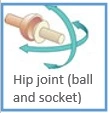 Hip joint will be involved in the hip flexion during the negative phase of squat. It is a ball and socket joint therefore it is flexible. The muscles that assist the hip joint during the movement are gluteus maximus and all three heads of hamstrings (biceps femoris, semitendinosus and semimembranosus).
Hip joint will be involved in the hip flexion during the negative phase of squat. It is a ball and socket joint therefore it is flexible. The muscles that assist the hip joint during the movement are gluteus maximus and all three heads of hamstrings (biceps femoris, semitendinosus and semimembranosus).
The second joint that is going to be involved in eccentric phase is knee joint (is the largest joint in human body) which is going to allow knee flexion. Knee joints are hinge joints. All quadriceps 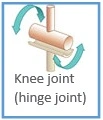 muscles (vastus lateralis, vastus medialis, vastus intermedialis and rectus femoris) are going to assist the knee joint extension.
muscles (vastus lateralis, vastus medialis, vastus intermedialis and rectus femoris) are going to assist the knee joint extension.
The third joint is ankle joint, which is involved in dorsiflexion as the angle between the tibia (shin bone) and phalanges (toe bones) decreases. Ankle joint during squat only allows dorsiflexion (during upward phase) and plantarflexion (during downward phase) movement, therefore it is also a hinge joint. Other joints are responsible for different movement in the ankle (subtalar joint) but it doesn’t assist during the dorsiflexion. Subtalar joint is going to be involved when athletes are going to have poor technique and one of the sides of the feet are going to come off the ground creating inversion if the inside of the of the foot is coming off the ground or eversion if the outside of the foot is coming off the ground. Feet should always be placed steady on the ground with equal distribution of the weight throughout the sole of the foot or in other cases more force should be put on the heels. The muscles that are going pull as a result of contracting to make ankle joints plantar flex are gastrocnemius (calves), soleus and other muscles such as tibial posterior muscle which are going to stabilise the movement.
At the bottom of the squat if it is held position, isometric contraction occurs which means that the muscles are still under load but no movement occurs.
The final phase of the squat is the concentric contraction where quadriceps muscles, contract/shorten and opposing muscles (hip flexors) lengthen. The joints that were involved during the eccentric phase, hip joints, knee joints and ankle joints are also going to be involved during the concentric phase but instead of flexion they are going to assist extension of the hip, knee and plantarflexion of the ankle as the angle between sole and tibia increases.
During all phases of squat back muscles and core muscles are going to be under pressure to ensure stabilisation.
The stance when squatting, for example wide or close is also going to determine where the emphasis on the muscle is placed. For example, when squatting with close stance the adductors are going to take more workload. When squatting frequently and under heavy load it is important to switch up the stance as the adductors can be overworked and cause pain.
Check out me squatting and make sure you subscribe, more videos to come:
Calories in vs Calories out (Energy intake & expenditure)
Energy expenditure also known as “calories out” is a combination of the energy that is being used (calories that are burned):
- during the rest,
- the energy that is required for other bodily functions such as digestion as well as
- the energy that is required for participating in physical activities.
The energy is measured in calories which are units of energy (1 calorie is 2 units of energy.)
There is small calorie also known as gram calorie. It is estimate of energy that is required to raise temperature in 1 gram of water by 1 degree (Celsius) in specific conditions (1 atmosphere).
The large calorie consists of 1000 small calories and is used as dietary calorie (also known as kilogram calorie (kcal). Respectively, this is the amount of energy that is required to raise kilogram of water in the same conditions. The carbohydrates, fats and proteins hold different energetic value. Carbohydrates and proteins are 4 kcal per every gram while fats are more than double at 9kcal per every gram.
WHAT AFFECTS ENERGY EXPENDITURE?
Firstly, the energy amount requirement at rest is also known as basal metabolic rate (BMR) which is the amount of calories (energy unit) that are burned without any physical activity.The calories are burned at rest state because the energy is required for blood circulation, respiration (breathing) and maintaining body temperature and building up (anabolism), breaking down (catabolism) cells in the body.
The amount of calories that are required for basal metabolic functions will depend on different variables such as gender, height and weight (lean body mass: amount of fat).
Secondly, the energy expenditure is also affected by the TEF (thermogenic effect of food). The thermic effect of food is the amount of energy that are required just to digest the food so it can then be utilised for energy (on average 10% off all food eaten is burned during digestive processes). Depending on what type of macronutrient is consumed the TEF will vary. Fats (2-3%) and carbohydrates 6 to 8% having lower percentage that is being burned during digestion that protein from which 25% or ¼ is burned up during digestion. Therefore diet higher in protein may aid fat loss as while eating the same amount of calories athlete may be able to decrease his weight more efficiently. The calories are burned during urination, flatulence and defecating.
Finally, the calorie expenditure (energy expenditure) will be influenced by physical activities. This will apply to every athlete as they will expend much higher amount of calories during high intensity exercise. Number of training hours a day and number of training days a week in addition to intensity level will affect the total number of calories that are expended. Calorie expenditure can be estimated by using different formulas.
There are two processes that occur in human body which are anabolism and catabolism. Catabolism is the breakdown cells which systematically occurs together with anabolism which is the building of the cells. Athletes will want to stay in anabolic state most of the time which will help them to increase performance and increase muscle mass.
CALORIE INTAKE – FOOD
The energy expenditure will be balanced with energy intake also known as “calories in”. Athletes will have to eat more food than regular person to compensate their high energy expenditure. This is crucial to sports performance as it helps to maintain high amount of energy, focus as well as reduce injury.
After determining basal metabolic rate athletes will have to determine their calorie maintenance level which is when calories in=calories out or energy intake=energy expenditure. This is when athlete will be maintaining his/her current weight. When athlete will have to increase their weight or increase their performance by increasing fitness components such as strength the calorie intake or energy intake will have to be higher than calorie out or energy expenditure. By doing this the athlete will achieve calorie surplus (positive energy balance). Calorie surplus can have a negative effect on people that are living sedentary lifestyle as it will result in weight gain which will be due to increase in the amount of adipose tissue instead of muscle.
The main preferred source of energy is carbohydrates. They fuel all processes in the body including the brain function which uses approximately 20% of daily energy (500kcal if male eats 2500kcal a day). All carbohydrates are converted into glucose but the time varies depending on the type of the carbohydrate (Simple/Complex) and other factors such as amount of fibre/fats in the meal. The secondary source of energy is fats, it can be referred to as a primary energy source during long duration activities. The proteins are used for building the cells in the body (muscles, nails, hair and blood). The required amount for athlete is much higher than someone who is sedentary and to who the government guidelines will apply. For athlete the requirement is higher as there is increased muscle breakdown (catabolism) therefore more protein is needed to rebuild (anabolism). The leaner person is the harder it is to maintain muscle mass, therefore when cutting/losing weight the amount of protein requirement will increase gradually. This also happens because there also is less amount of total energy (calorie deficit). If eating at or above maintenance it will be 0.8 to 1.2 grams per kilogram of body weight per day whereas if eating below the maintenance it doubles to around 1.6 to 2.7 grams per kilogram of body weight per day. The protein intake will depend on various other factors. Athlete will have higher requirement as he/she will train for specific goals with progression which will require both calorie surplus and higher protein intake when compared to someone who is doing light exercise without specific training goals. In some cases doctors might recommend a low protein diet for medical reasons person is having. In most cases when there are no medical restrictions, athlete wants to gain muscle mass or maintain it and has low body fat percentage the protein requirement will be in range from 1.6g to 2.7g per every kilogram of body weight. The protein is not classified as an energy source but it can be converted into glucose during a process of gluconeogenesis.
For athletes it is recommended to eat in slight calorie surplus usually 300-500kcal surplus as in this way they will be able to avoid adding unnecessary weight in form of adipose tissue.
In conclusion:
- To gain weight – eat in caloric surplus
- To lose weight – eat in caloric deficit
- To maintain weight – eat at caloric maintenance
Read here how to calculate your calorie intake
Micronutrients101
Micronutrients which are the vitamins and minerals that are mainly received by consuming fruit and vegetable rich diet.
Micronutrients are chemical elements/substances that help to produce enzymes and hormones. The government has introduced 5 a day to invite and encourage people consume more micronutrient rich foods. Different coloured vegetables should be eaten. Several vitamins such as vitamin D might have to be supplemented due current living standards. Most people are not getting enough sunlight especially those living in areas further away from equator. Micronutrient rich foods will help to improve immunity (Vitamin C) and avoid diseases and cancers. It is recommended to intake most of the vitamins from whole foods (fruits/vegetables) as there is not complete evidence that supplementation of vitamins have actual measurable health benefits.
The vitamin requirement is going to depend on the individual, people who are physically active during the most days of the week will have higher vitamin requirement, in contrast someone who lives sedentary lifestyle might follow the RDA by government. Different groups of people such as elderly, obese as well as ill or injured will also have higher vitamin requirement. People who are limiting certain foods, such as vegans could develop micronutrient deficiencies (for example B12 which can only be found in animal foods (naturally)). Iron deficiency is one of the most common vitamin deficiencies in the world. However people should be careful supplementing metals as excessive supplementation could lead to toxicity or other micronutrient deficiencies as they are not absorbed properly.
Protein101
Protein makes up around 20% of the body and is needed to build and repair muscle tissue and also repairs red blood cells, helps with growth of hair and fingernails. It is needed for digestion and transportation of nutrients to cells and from them. The excess protein is not likely to be stored as fat because the processes the body would have to go through are very complicated. Any excess protein that body is not utilizing to make enzymes, make hormones, rebuilt muscle tissue or any sort of metabolic functions is converted by liver into carbohydrates. However it is possible to gain fat by consuming excess protein if consumed in large quantities. The fat would be gained at a much slower rate. Metabolic processes anabolism (building cells) and catabolism (breaking down cells) occur all the time. The protein requirements for men is 55g per day and for women it is 45g. The government guidelines for protein are so low because mainstream nutritionists that work for government/nutrition follow the principle that the body is recycling metabolised protein which means that the requirement does not have to be so high when compared to someone who is athlete. Examples of protein sources include animal protein (beef, chicken, cheese, eggs, and fish), vegetable protein (beans, seeds and nuts)
Athletes will require anywhere from 1.6 to 2.7 grams of protein per kg. Typical recommendation being 1g per each lbs of target body weight. Someone who would wish to gain weight and their target weight is 180lbs would have to intake 180g of protein per day. Protein plays important role when athlete is trying to lose weight. This is because of the TEF (thermic effect of food) which means that 25% of protein is going to be burned on digestion. When comparing to fat and carbs this is just 3% and 7% accordingly.
Fats101
Fats are needed to maintain healthy body, healthy hormonal levels, protect organs, brain function and also to help the vitamins to absorb because vitamins such as A, D, E and K are fat soluble.
There are two main types of fats which are saturated and unsaturated.
Saturated fats are being referred to as bad fats while unsaturated fats which divide into:
- monounsaturated fatty acids (MUFAs) and
- polyunsaturated fatty acids (PUFAs). Important PUFAs are omega-3 and omega-6 which are essential fatty acids as they can’t be produced by human body and has to be consumed by foods such as fish and nuts. Most of the foods in diet consist more Omega-6 and less Omega-3. One of the best examples being almonds which have 2000 times more Omega-6 than Omega-3.
Saturated fat can lead to high cholesterol levels including heart disease. Dopamine (pleasure chemical), estrogen (has a role in determining what is used for fuel while exercising- carbohydrates or fat) as well as decrease in LDL (low-density lipoprotein) cholesterol (bad cholesterol) and increase in good cholesterol HDL (high-density lipoprotein). It is important to have low LDL cholesterol as it can block the walls of the arteries. A high HDL can contribute in preventing cardiovascular system problems as studies show it carries cholesterol away from arteries to the liver. The fat sources highest in saturated fat include butter, raw coconut milk and coconut oil. Fat sources highest in monounsaturated fat include sources such as avocado (9.9g carbs per 200g serving and almonds 8.7g per just 1oz/28g serving. Fat sources highest in polyunsaturated fats include whole flaxseeds (2.8g per 14g serving), fish oil (2g per 5g serving).
The RDA for fats is 95g for men and 70g for women further breaking down into 30g of saturated and 60g of unsaturated for men and for women 20g saturated and 50g unsaturated.
For athletes the required amount is calculated by multiplying target body weight by 0.4-0.7. The number you multiply will depend on different factors such as insulin resistance or simply preference (fats over carbs or vice versa).
Fibre101
Fibre is a carbohydrate which is responsible for regulating digestion as well as blood sugar levels and hunger. The fibre will help with regular bowel movements. There are 2 types of fibre, soluble and insoluble.
Soluble fibre pulls water. It keeps food in stomach longer as the digestion slowed down. For the same reason it helps to regulate the blood sugar levels, for example apple will be broken down slower (as it has fibre (2.4g per 100g)) than apple juice which is processed and has decreased amount of fibre therefore the blood sugar levels will be spiked much faster. Current guidelines suggest that there has to be at least 3g of fibre per 100g of fibre source food (oats, pasta, vegetables) therefore the RDA is 1.5 grams per 100kcal. For men the total recommended calorie intake is 2500kcal and for women it is 2000kcal therefore fibre intake for men should be 37.5g and for women 30g.
Insoluble fibre helps with the gut health as it helps with the bowel movement. Most whole grains and vegetables have it. Fibre is important as it helps to reduce the blood pressure level mainly with people who have mild hypertension. It helps to regulate weight as a result of increased satiation and fullness feeling – meaning the person will be more likely to consume less amount of calories. Fibre is proven to help to protect against colon cancer which is in the top 8 causes of death in the UK and in the top 3 in the USA. This displays a link between poor nutrition and increase in the cause of the death in these countries. Also fibre is referred to as negative calories as the fibre is not digestible. Satiation means that the stomach will fill up faster this is observable when on athlete is on a diet and his/her diet consists of vegetables which are high in fibre. Fullness feeling means that there will be more time between meals as the athlete won’t feel as hungry. Hunger occurs when blood sugar levels decrease and could lead to energy loss.
To sum up,
Soluble fibre:
- Slows down digestion
- Regulates blood sugar
Insoluble fibre:
- Healthy gut
- Regular, healthy bowel movement
- Increased satiation, fullness
- Decreased risk of colon cancer
Carbohydrates101
Carbohydrates are the main energy source examples include grains (oats, rice, wheat), tubers (potatoes and sweet potatoes). Carbohydrates are divided into simple carbohydrates and complex carbohydrates. They differ in the way they are built (simple carbs having one or two molecules and complex carbohydrates having chain of molecules) as well as the way they are absorbed.
Simple carbohydrates can be either monosaccharides (glucose (found in plants), fructose (found in fruit)) or disaccharide (sucrose/table sugar). Simple carbohydrates will have high Glycaemic Index (GI) which mean that the blood glucose levels will be raised much faster when compared to Complex carbohydrates which have low GI.
Complex carbohydrates also known as starches are polysaccharides. There is a problem with the carbohydrate classification which is that complex carbohydrates are considered to be more superior which is not always true. For example when comparing apples and white bread. The bread is considered to be complex carbohydrate but as it is very processed it has lost most of its micronutrients therefore it should not be superior to apple which has far more micronutrients but is considered to be a source of simple carbohydrates. Another issue with carbohydrates is that it is considered to be what makes people fat which is not true.
It all comes down to daily calorie intake (food) versus the calorie expenditure (through metabolic processes (brain function requiring 20% of the total energy, exercising). Eating in calorie surplus will cause weight gain while eating in calorie deficit will cause weight loss. By percentage, someone who is obese and whose diet consists of 45% carbohydrates can be eating the same amount of percentage as someone who is slim. This provides an example that the problem is simply overeating.
The RDA (Recommended Daily Amounts) for men and women are 300 grams which would equal to 1200 calories. The recommendations for athletes are higher as their energy requirement is higher. There are different sources for the assumed carbohydrate needs.
For someone who is exercising several times per week it will be anywhere between 3-5g per kg.
For someone who is serious about sports and exercises 2-3 hours per day, 5-6 days per week the carbohydrate intake will increase to 5-8 grams per kg.
For elite athletes the daily requirements are 8-10g per day on kg. These are just guidelines and each individual should be assessed individually as their metabolism could be very fast (ectomorphs) therefore requiring higher amount of total calories (will be achieved by increasing amount of carbohydrates instead of protein and fat as they mostly stay the same throughout the diet planning). The opposite would be endomorph whose metabolism will be slow and he/she will require less calories therefore the amount of carbohydrates will be smaller. In this case protein and fat will also stay the same to maintain basic functions of the body. Exception is to someone who is insulin sensitive. They will respond better to low-fat diet (decreasing amount of fat instead of carbs) as Obesity study “Insulin sensitivity determines the effectiveness of dietary macronutrient composition on weight loss in obese women” suggests. Also eating enough carbohydrates will ensure that the protein is not converted in glucose which would be a negative as there the protein eaten then wouldn’t be enough for its main purpose which is repairing catabolised (broken down) tissue.
Carbohydrates are crucial for athletic performance such as endurance events and team sports (football, basketball).
Importance of diet
Diet has a major role in a healthy lifestyle. Many people don’t realise that the best results come when training is combined with efficient nutrient intake and rest. During training muscles are broken down and they need to be repaired which happens during sleep. A person should eat a balanced diet which means he has to include all 3 macronutrients: carbohydrates, protein and fats. Instead of trying to find a “magic pill” or magic way how to lose body fat learn how your body works! Stop with the crazy diets where you eliminate fats or other macronutrient. Each has it’s purpose in human body and are equally important – see posts about each macronutrient by clicking on the name (carbohydrates, protein, fats).
Water intake is as important as diet itself, therefore you should ensure that you drink plenty of water during the day. It is also important to eat micronutrient rich foods which will provide all vitamins and minerals for his body to function properly. Instead of looking for “super foods” all the time keep it simple. Stick to the basics. Be consistent. Eventually the results will come. Water is very important and a person should drink at least 2.5 to 3 litres of water a day (the water intake may vary depending on different factors such as:
- Supplementation ( +1 litre more if creatine is used) – see post about supplementation
- Activity levels
- Weather conditions
My strategy of water intake.
Water intake should be split throughout the day. I drink around 0.5 litres-1 litre of water after sleep because the body gets dehydrated during the night. Urine always should be transparent and colorless. Anything dark will indicate dehydration.



